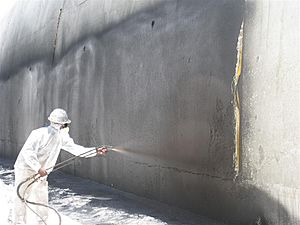Waterproofing facts for kids
Waterproofing is all about making things resistant to water. It means protecting an object or building so that water doesn't get inside or cause damage. This is super important for things that are used in wet places or even underwater.
You might hear terms like water-resistant and waterproof. Water-resistant means something can handle a bit of water, like a light rain. Waterproof means it can stop water even under pressure, like when it's fully submerged. There's also damp proof, which is about stopping humidity or moisture, not just liquid water.
Long ago, people waterproofed boats with sticky tar. Today, we use special coatings or seal up gaps with things like gaskets. Waterproofing is used for many things, from building basements and boats to raincoats and even smartphones!
Contents
Waterproofing Buildings and Structures
In construction, waterproofing protects buildings from water. This keeps the inside dry and helps the building last longer. It's a key part of creating a "building envelope," which is like the protective skin of a building.
Keeping Roofs and Walls Dry
Roofs are usually designed to shed water, but sometimes they need to be fully waterproof, especially on flat roofs or where ice can build up. Many types of waterproof layers are used, like special sheets made from asphalt or rubber-like materials.
Walls also need protection. They use special wraps that let moisture out but keep rain from getting in. Walls can also have vapor barriers to control moisture. For foundations, a "damp-proof course" stops moisture from rising up the walls from the ground. Concrete foundations are often coated or have special sheets placed under them to keep them dry.
Waterproofing Underground Areas
When building underground, there are two main ways to waterproof:
- Tanking: This is for areas that might be in constant water, like a basement built below the water level. It means completely wrapping the underground structure in a strong waterproof layer, like a tank. This stops water pressure from pushing through.
- Damp Proofing: This is for areas where the ground is usually dry and water drains away easily. It mainly stops moisture and water vapor from getting in, without dealing with strong water pressure. A "damp proof membrane" (DPM) is used for this.
For buildings that are partly underground, like earth sheltering homes, waterproofing is super important. If water gets in, it can cause mold to grow, which can damage the building and affect air quality.
Protecting Decks and Balconies
Waterproofing decks and balconies is a very specialized job. If it's not done right, water can leak into the building below, causing a lot of damage. It's important to use the correct products and follow the instructions carefully. Decks also move a lot with temperature changes, which can stress the waterproof layers. A good waterproof deck system includes the right membrane, proper slopes for drainage, and good construction materials.
New Ways to Waterproof Concrete
In recent years, new waterproofing materials have been developed. Some "integral waterproofing systems" are mixed right into the concrete. This makes the concrete itself waterproof!
- Hydrophilic systems use chemicals that react with the concrete to form crystals, filling up tiny holes and blocking water.
- Hydrophobic systems use special liquids or fatty acids that make the concrete repel water.
Sometimes, the same materials that keep water out of buildings are used to keep water in, like for swimming pools or pond liners. Newer waterproof layers often use polymer-based materials that stick well to surfaces, creating a seamless barrier.
It's important to remember that waterproofing is different from just putting a roof on. A roof sheds water, but true waterproofing can stop water even under pressure.
Waterproof Clothing and Gear
Many clothes and tents are made to protect you from rain. You might see terms like "showerproof," "water resistant," and "waterproof."
- Showerproof items have a light coating and are good for very light rain.
- Water-resistant items are a bit better but still not fully waterproof.
- Waterproof garments have a special coating and their seams are sealed. The best waterproof clothes also have a special membrane that keeps rain out but lets your body sweat escape, so you don't feel clammy. These garments often have a "hydrostatic rating" that tells you how much water pressure they can handle, from light rain to heavy downpours.
Waterproof clothes are also usually good at blocking wind. Your shoes can also be made waterproof using things like beeswax or special sprays.
Waterproofing Other Objects
Waterproofing is used for many other things, like paper packaging and even electronic devices. For a long time, electronics for military use were coated to resist moisture. But now, you can find waterproof smartphones and tablets!
This is often done using a special nanotechnology coating. This coating is incredibly thin, much thinner than a human hair, and it protects the electronics from water damage. Some companies use this "nano coating" method for their phones, tablets, and digital cameras.
Scientists have also found that surfaces with tiny cone shapes, called "nanocones," can be "superhydrophobic" – meaning they hate water so much that water droplets just roll right off them!
Images for kids







